Red Clover
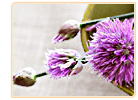 Red clover is a variety of clover that derives its name from its distinctive appearance. Its vibrant red, pink and purple petals are easily identifiable. Red clover�s unique chemical properties mean that it is often used to treat menopause symptoms and considered one of the most common herb for menopause. Its health benefits are plentiful, but there are side effects too. The worst of these is the possible advancement of certain types of cancer, such as breast cancer. Red clover is a variety of clover that derives its name from its distinctive appearance. Its vibrant red, pink and purple petals are easily identifiable. Red clover�s unique chemical properties mean that it is often used to treat menopause symptoms and considered one of the most common herb for menopause. Its health benefits are plentiful, but there are side effects too. The worst of these is the possible advancement of certain types of cancer, such as breast cancer.
What is Red Clover?
Red clover is a perennial clover plant that originates from Asia, parts of Northern Africa, and Central Europe. Its high mineral and vitamin content is used to boost human cell regeneration and strength, both of which are key to fighting illness. Red clover is also greatly sought-after in easing menopausal symptoms, such as hot flashes and night sweats.
The red clover flower is easily identifiable due to its vibrant shades of light pink and red.
History of Red Clover
In ancient times, the Greeks, Celts, and Romans considered red clover a magical plant that could ward off evil. People believed that clovers with four leaves were particularly lucky. Throughout history red clover has been used in a variety of ways. These include:
. Medicinally
. Gastronomically
. Agriculturally
Different Names for Red Clover (Synonyms - Etymology)
The name 'clover' comes from red clover�s sticky nectar, which is one of the ingredients in a popular type of honey. Red clover is known by various other names. These include:
 . Beebread . Beebread
. Cow clover
. Meadow clover
How Does Red Clover Grow
 The red clover seed needs considerable exposure to the sun in order to grow. For red clover seeds to grow best, its seeds should be planted in moist but well-drained soil. The red clover seed needs considerable exposure to the sun in order to grow. For red clover seeds to grow best, its seeds should be planted in moist but well-drained soil.
Red clover can be found growing wild along roadsides and in ditches because its sunlight and soil requirements are easily met.
What Does Red Clover Look Like?
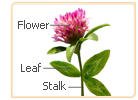 Red clover is easily recognizable by its petals, the colors of which range from soft shades of pink to vibrant reds. Such colorful flowers grow from its large v-shaped leaves, which usually appear in arrangements of three. The leaves usually grow to between 8-15mm wide, and 15-30mm long, and are green in color. Red clover is easily recognizable by its petals, the colors of which range from soft shades of pink to vibrant reds. Such colorful flowers grow from its large v-shaped leaves, which usually appear in arrangements of three. The leaves usually grow to between 8-15mm wide, and 15-30mm long, and are green in color.
Click on the following link to read more about what red clover is, or continue reading to learn about how it works.
How Does Red Clover work?
To ancient war-faring civilizations such as the Romans and Greeks, red clover was a sacred plant that would often be worn against the chest for good luck.
Because of its chemical properties, red clover has multiple uses and benefits humans, animals, and insects alike.
Properties of Red Clover
Trifolium Pratense is the scientific name for red clover. It contains a high content of the compound isoflavones which benefits mammals in particular.
Isoflavones act as phyto-estrogens in the bodies of mammals and can replace human hormones with those of plants.
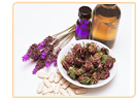 Red clover also contains the following minerals: Red clover also contains the following minerals:
. Magnesium
. Calcium
. Potassium
. Chromium
How Does Red Clover Work With the Body?
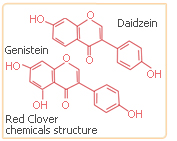 The isoflavones in red clover balance the body's estrogen levels by copying estrogen. This process is often used by menopausal women suffering from a hormone imbalance. The isoflavones in red clover balance the body's estrogen levels by copying estrogen. This process is often used by menopausal women suffering from a hormone imbalance.
However, dangerous side effects can sometimes result from adding artificial hormones to the body.
Red clovers� properties also comprise a chemical compound called coumarins. Testing has found it capable of thinning and purifying the blood of mammals.
Click on the following link to learn more about how red clover works, or continue reading below to find out how it is used.
How is Red Clover Used?
Red clover is used to treat a range of problems because it has many medicinal properties. These vary from the treatment of menopausal symptoms that occur in middle-aged women to problematic skin conditions.
The properties of red clover also comprise a high level of minerals and vitamins and, subsequently, are often used to strengthen the body's immune system.
The Uses of Red Clover Throughout History
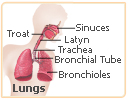 The numerous of ways in which red clover can be used is the reason it has been so popular with many cultures and peoples. The numerous of ways in which red clover can be used is the reason it has been so popular with many cultures and peoples.
Medical practitioners in China have been using it for hundreds of years to cure respiratory problems. In Russia, folk healers have also been using red clover in the same way.
Red clover has a long history of use in the treatment of eczema, cancer, and venereal diseases because it was considered a "blood purifier" and was believed to purify the blood in reaction to such conditions.
Modern Day Uses of Red Clover
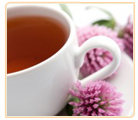 Blood thinner: When used in this way, red clover can help prevent blood clots and lower cholesterol, which in turn reduces the risk of a stroke. Blood thinner: When used in this way, red clover can help prevent blood clots and lower cholesterol, which in turn reduces the risk of a stroke.
Menopause: The isoflavones in red clover imitate estrogen and balance the body's estrogen levels which ease menopause symptoms.
Bites and stings: For insect bites or stings, a freshly crushed flower applied to the wound can ease its severity.
The Forms of Red Clover
Clinical studies have shown that the red clover plant acts as a blood thinner when consumed in its uncooked form. However, it can be used in a variety of ways. These include: Extract for pills, tea, and syrup.
Dosage of Red Clover
For prescriptions of red clover, a standardized measure of 40mg is normally used per tablet or capsule.
80 mg in the form of two 40mg pills is advisable for menopause treatment.
Dried Herb: No more than two-three cups should be consumed daily and this should be taken in a specific way; 1-2 tsp of dried flowers or flowering tops should be put into approximately 8 oz. of hot water for 30 minutes.
Click on the following link to read more about how red clover is used, or continue reading below to learn about its benefits..
Red Clover Benefits
 The Chinese recognized early on that red clover was able to rid the blood and liver of toxins by functioning as a diuretic, and helping the body get rid of excess fluid. Red clover has also long been used by the Russians to cure respiratory infections and nasal congestion. The Chinese recognized early on that red clover was able to rid the blood and liver of toxins by functioning as a diuretic, and helping the body get rid of excess fluid. Red clover has also long been used by the Russians to cure respiratory infections and nasal congestion.
Red clovers� health benefits are based primarily in the distinctively colored petals from which the herb takes its name. Red clover has many benefits.. One of its primary health benefits is that it contains coumarins, a substance that thins and purifies the blood.
Specific Red Clover Benefits
Menopause: Red clovers' benefits have been concretely proven to help relieve various symptoms of menopause. Including night sweats and hot flashes.
Menopause symptoms are the result of a drop in estrogen. This drop causes hormone imbalance in middle-aged women. Isoflavones are capable of augmenting and stabilizing these lowered hormonal levels, curbing the severity of these symptoms.
Cardiovascular health: The isoflavones in red clover are capable of boosting "good" HDL cholesterol in pre and post-menopausal women.
Skin conditions: For dry-skin conditions such as eczema, red clover oils have mild inflammatory properties that sooth the effects of such conditions.
Cancer: Red clover�s benefits are such that its anti-cancer agents have occasionally been used to treat cancerous wounds that emerge on the skin.
Click on the following link to read more about the benefits of red clover, or continue reading below to learn about its side effects.
Red Clover Side effects
Red clovers� phyto-estrogen compounds carry health benefits but can also produce various side effects. Such side effects are the result of a change in the natural balance of chemicals in the body.
Side Effects of Using Red Clover
 The ordinary side effects of red clover are also the least serious and generally do not necessitate medical attention. These include headaches and nausea. The ordinary side effects of red clover are also the least serious and generally do not necessitate medical attention. These include headaches and nausea.
More serious side effects can include:
. Liver damage
. Abnormal vaginal bleeding
. Possible infertility
Interactions Between Red Clover and Health Conditions
Cancer: Red clover�s cancer benefits are such that it is known to prevent some types of cancer; however, its estrogen-like effects may contribute to the growth of other types of cancer, and interfere with the treatment of others.
 Diabetes: Red clover may lower blood sugar levels. Diabetes: Red clover may lower blood sugar levels.
Those who are Pregnant, Breast-Feeding, Undergoing Hormone Therapy or taking birth control pills: Red clovers� properties can have significant effects on the production of estrogen-like chemicals in the body. Because these effects have not been tested among these groups of women, the consumption of red clover isn't advised.
People on Blood-Thinning Drugs: Red clover is a blood thinner that prevents blood clots from forming. This is particularly beneficial for those at risk of a stroke, heart attack or aneurism.
Some Menopause Symptoms: As a phytoestrogenic herb, red clover adds estrogen-like hormones to the body. Since menopause is characterized by lowered and weak levels of estrogen in the body, red clover can help ease some menopause symptoms.
Click on the following link to read more about the side effects of red clover, or continue reading below to learn about how it works with regards to menopause.
Red Clover and Menopause
 Menopause symptoms occur as a result of lowered and weak levels of estrogen in the body. The body's struggle to cope with these altered hormone levels is what drives most of the symptoms behind menopause. Common symptoms include hot flashes, night sweats, and loss of libido. Menopause symptoms occur as a result of lowered and weak levels of estrogen in the body. The body's struggle to cope with these altered hormone levels is what drives most of the symptoms behind menopause. Common symptoms include hot flashes, night sweats, and loss of libido.
Red clovers' estrogen-like properties are what make it so effective in treating menopause symptoms.
Red Clover For Menopausal Women
Hot Flashes: Red clovers' isoflavones have been used for many years to help relieve hot flashes, which are caused by wildly fluctuating levels of estrogen in the body. Hot flashes are characterized by a feeling of intense heat, accompanied by sweating and a rapid heartbeat.
Night Sweats: Menopausal women often experience night sweats, which are what hot flashes are called when they occur at night. Red clovers' isoflavones can be used to ease this symptom of menopause.
 Cardiovascular Health: Taking red clover can boost menopausal women�s cardiovascular health. Its estrogen-like properties also strengthen the arteries, which allow the heart to pump blood with less strain. Cardiovascular Health: Taking red clover can boost menopausal women�s cardiovascular health. Its estrogen-like properties also strengthen the arteries, which allow the heart to pump blood with less strain.
Bone Density-Loss: Red clovers' estrogen-like properties make it successful in slowing done bone-density and bone-mineral loss in pre and post-menopausal women.
Click on the following link to read more about Red Clover and menopause.
Which herb should women try? Today women are looking for relief from their menopause symptoms with herbs. Phytoestrogenic herbs and non-estrogenic herbs are good in relieving menopause symptoms, but recent studies show that non-estrogenic herbs have no side effects because they help the body to produce its own hormones instead of introducing hormones like the phytoestrogenic ones. Learn more about non-estrogenic herbs for menopause.
| 

